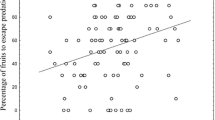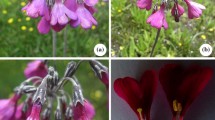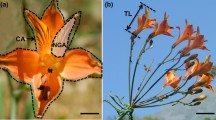Abstract
The coexistence of different color morphs is often attributed to variable selection pressures across space, time, morph frequencies, or selection agents, but the routes by which each morph is favored are rarely identified. In this study we investigated factors that influence floral color polymorphisms on a local scale in Protea, within which approximately 40% of species are polymorphic. Previous work shows that seed predators and reproductive differences likely contribute to maintaining polymorphism in four Protea species. We explored whether selection acts directly or indirectly on floral color in two populations of Protea aurea, using path analysis of pollinator behavior, nectar production, seed predation, color, morphology, and maternal fecundity fitness components. We found that avian pollinators spent more time on white morphs, likely due to nectar differences, but that this had no apparent consequences for fecundity. Instead, the number of flowers per inflorescence underpinned many of the reproductively important differences between color morphs. White morphs had more flowers per inflorescence, which itself was positively correlated with nectar production, seed predator occurrence, and total long-term seed production. The number of seeds per plant to survive predation, in contrast, was not directly associated with color or any other floral trait. Thus, although color differences may be associated with conflicting selection pressures, the selection appears to be associated with the number of flowers per inflorescence and its unmeasured correlates, rather than with inflorescence color itself.



Similar content being viewed by others
References
Adler L, Karban R, Strauss SY (2001) Direct and indirect effects of alkaloids on plant fitness via herbivory and pollination. Ecology 82:2032–2044
Aizen MA, Basilio A (1998) Sex differential nectar secretion in protandrous Alstroemeria aurea (Alstroemeriaceae): is production altered by pollen removal and receipt? Am J Bot 85:245–252
Armbruster WS (2002) Can indirect selection and genetic context contribute to trait diversification? A transition-probability study of blossom-colour evolution in two genera. J Evol Biol 15:468–486
Ashman TL, Stanton ML (1991) Seasonal variation in pollination dynamics of sexually dimorphic Sidalcea oregana spp. spicata (Malvaceae). Ecology 72:993–1003
Barrett JA (1988) Frequency-dependent selection in plant fungal interactions. Philos Trans R Soc Lond Ser B Biol Sci 319:473–483
Bell G, Lefebvre L, Giraldeau LA, Weary D (1984) Partial preference of insects for the male flowers of an annual herb. Oecologia 64:287–294
Boose DL (1997) Sources of variation in floral nectar production rate in Epilobium canum (Onagraceae): implications for natural selection. Oecologia 110:493–500
Bowman RN (1987) Cryptic self-incompatibility and the breeding system of Clarkia unguiculata (Onagraceae). Am J Bot 74:471–476
Burdon JJ, Marshall DR, Brown AHD (1983) Demographic and genetic changes in populations of Echium plantagineum. J Ecol 71:667–679
Calf KM, Downs CT, Cherry MI (2003a) Territoriality of Cape Sugarbirds (Promerops cafer) between and within breeding seasons. Ostrich 74:125–128
Calf KM, Downs CT, Cherry ML (2003b) Foraging and territorial behaviour of male Cape and Gurney’s sugarbirds (Promerops cafer and P. gurneyi). Afr Zool 38:297–304
Campbell DR (1996) Evolution of floral traits in a hermaphroditic plant: field measurements of heritabilities and genetic correlations. Evolution 50:1442–1453
Cariveau D, Irwin RE, Brody AK, Garcia-Mayeya L, von der Ohe A (2004) Direct and indirect effects of pollinators and seed predators to selection on plant and floral traits. Oikos 104:15–26
Carlson JE (2007) Male-biased nectar production in a protandrous herb matches predictions of sexual selection theory in plants. Am J Bot 94:674–682
Carlson JE (2008) Hummingbird responses to gender-biased nectar production: are nectar biases maintained by natural or sexual selection? Proc R Soc B Biol Sci 275:1717–1726
Carlson JE, Harms KE (2006) The evolution of gender-biased nectar production in hermaphroditic plants. Bot Rev 72:179–205
Carlson JE, Holsinger KE (2010) Natural selection on inflorescence color polymorphisms in wild Protea populations: the role of pollinators, seed predators and inter-trait correlations. Am J Bot 97:934–944
Carlson JE, Holsinger KE, Prunier R (2011) Plant responses to climate in the Cape Floristic Region of South Africa: evidence for adaptive differentiation in the Proteaceae. Evolution 65:108–124
Carroll AB, Pallardy SG, Galen C (2001) Drought stress, plant water status, and floral trait expression in fireweed, Epilobium angustifolium (Onagraceae). Am J Bot 88:438–446
Caruso CM, Scott SL, Wray JC, Walsh CA (2010) Pollinators, herbivores, and the maintenance of flower color variation: a case study with Lobelia siphilitica. Int J Plant Sci 171:1020–1028
Coberly LC, Rausher MD (2003) Analysis of a chalcone synthase mutant in Ipomoea purpurea reveals a novel function for flavonoids: amelioration of heat stress. Mol Ecol 12:1113–1124
Coberly LC, Rausher MD (2008) Pleiotropic effects of an allele producing white flowers in Ipomoea purpurea. Evolution 62:1076–1085
Coetzee JH, Giliomee JH (1987a) Borers and other inhabitants of the inflorescences and infructescences of Protea repens in the Western Cape. Phytophylactica 19:1–6
Coetzee JH, Giliomee JH (1987b) Seed predation and survival in the infructescences of Protea repens (Proteaceae). S Afr J Bot 53:61–64
Coetzee JH, Littlejohn GM (2007) Protea: a floricultural crop from the cape floristic kingdom. In: Scripta Horticulturae No. 5: Proteaceous ornamentals: Banksia, Leucodendron, Leucospermum and Protea. International Society for Horticultural Science and the International Protea Association, Gent-Oostakker, pp 77–112
Collins BG, Rebelo AG (1987) Pollination biology of the Proteaceae in Australia and southern Africa. Aust J Ecol 12:387–421
Cresswell JE, Galen C (1991) Frequency-dependent selection and adaptive surfaces for floral character combinations—the pollination of Polemonium viscosum. Am Nat 138:1342–1353
Cruden RW, Hermann SM, Peterson S (1983) Patterns of nectar production and plant–pollinator coevolution. In: Bentley B, Elias T (eds) The biology of nectaries. Columbia University Press, New York, pp 80–125
Cserti CM, Dzik WH (2007) The ABO blood group system and Plasmodium falciparum malaria. Blood 110:2250–2258
Delph LF (1996) Flower size dimorphism in plants with unisexual flowers. In: Lloyd D, Barrett S (eds) Floral biology. Chapman and Hall, New York, pp 217–240
Eckhart VM, Rushing NS, Hart GM, Hansen JD (2006) Frequency-dependent pollinator foraging in polymorphic Clarkia xantiana ssp. xantiana populations: implications for flower colour evolution and pollinator interactions. Oikos 112:412–421
Elam DR, Linhart YB (1988) Pollination and seed production in Ipomopsis aggregata: differences among and within flower color morphs. Am J Bot 75:1262–1274
Ennos RA, Clegg JB (1983) Flower color variation in the morning glory, Ipomoea purpurea. J Hered 74:247–250
Evans MEK, Holsinger KE, Menges ES (2010) Fire, vital rates, and population viability: a hierarchical Bayesian analysis of the endangered Florida scrub mint. Ecol Monogr 80:627–649
Falconer DS (1989) Introduction to quantitative genetics, 3rd edn. Wiley, New York
Fineblum WL, Rausher MD (1997) Do floral pigmentation genes also influence resistance to enemies? The W locus in Ipomoea purpurea. Ecology 78:1646–1654
Forsyth GG, van Wilgen BW (2007) An analysis of fire history records from protected areas in the western cape. CSIR report CSIR/NRE/ECO/ER/2007/0118/C. CSIR Natural Resources and the Environment, Stellenbosch
Frey FM (2004) Opposing natural selection from herbivores and pathogens may maintain floral-color variation in Claytonia virginica (Portulacaceae). Evolution 58:2426–2437
Frey FM (2007) Phenotypic integration and the potential for independent color evolution in a polymorphic spring ephemeral. Am J Bot 94:437–444
Galen C, Kevan PG (1980) Scent and color, floral polymorphisms and pollination biology in Polemonium viscosum Nutt. Am Midl Nat 104:281–289
Galeotti P, Rubolini D, Dunn PO, Fasola M (2003) Colour polymorphism in birds: causes and functions. J Evol Biol 16:635–646
Gegear RJ, Laverty TM (2001) The effects of variation among floral traits on the flower constancy of pollinators. In: Chittka L, Thomson JD (eds) Cognitive ecology of pollination. Cambridge University Press, Cambridge, pp 297–317
Gigord LDB, MacNair MR, Smithson A (2001) Negative frequency-dependent selection maintains a dramatic flower color polymorphism in the rewardless orchid Dactylorhiza sambucina (L.) Soo. Proc Natl Acad Sci USA 98:6253–6255
Gomez JM (2000) Phenotypic selection and response to selection in Lobularia maritima: importance of direct and correlational components of natural selection. J Evol Biol 13:689–699
Gomez JM (2003) Herbivory reduces the strength of pollinator-mediated selection in the Mediterranean herb Erysimum mediohispanicum: consequences for plant specialization. Am Nat 162:242–256
Goplen BP (1992) A recessive gene for white sepal color in sweetclover, Melilotus alba L. Can J Plant Sci 72:1259–1262
Gray SM, McKinnon JS (2007) Linking color polymorphism maintenance and speciation. Trends Ecol Evol 22:71–79
Greenwood JJD (1985) Frequency-dependent selection by seed-predators. Oikos 44:195–210
Haldane JBS (1949) Disease and evolution. La Ricerca Scientifica Suppl A19:325–335
Hamback PA (2001) Direct and indirect effects of herbivory: feeding by spittlebugs affects pollinator visitation rates and seedset of Rudbeckia hirta. Ecoscience 8:45–50
Hanley ME, Lamont BB, Armbruster WS (2009) Pollination and plant defence traits co-vary in Western Australian Hakeas. New Phytol 182:251–260
Hedrick PW (1986) Genetic polymorphism in heterogeneous environments: a decade later. Annu Rev Ecol Syst 17:535–566
Hedrick PW (2006) Genetic polymorphism in heterogeneous environments: the age of genomics. Annu Rev Ecol Evol Syst 37:67–93
Hiscock SJ, McInnis SM (2003) The diversity of self-incompatibility systems in flowering plants. Plant Biol 5:23–32
Hodges SA (1993) Consistent interplant variation in nectar characteristics of Mirabilis multiflora. Ecology 74:542–548
Hurly AT (1996) Spatial memory in rufous hummingbirds: memory for rewarded and non-rewarded sites. Anim Behav 51:177–183
Irwin RE (2000) Hummingbird avoidance of nectar-robbed plants: spatial location or visual cues. Oikos 91:499–506
Irwin RE, Strauss SY, Storz S, Emerson A, Guibert G (2003) The role of herbivores in the maintenance of a flower color polymorphism in wild radish. Ecology 84:1733–1743
Johnson ET, Berhow MA, Dowd PF (2008) Colored and white sectors from star-patterned petunia flowers display differential resistance to corn earworm and cabbage looper larvae. J Chem Ecol 34:757–765
Jones KN, Reithel JS (2001) Pollinator-mediated selection on a flower color polymorphism in experimental populations of Antirrhinum (Scrophulariaceae). Am J Bot 88:447–454
Kearns CA, Inouye DW (1993) Techniques for pollination biologists. University Press of Colorado, Niwot
Koes RE, Quattrocchio F, Mol JNM (1994) The flavonoid biosynthetic pathway in plants: function and evolution. Bioessays 16:123–132
Lande R, Arnold SJ (1983) The measurement of selection on correlated characters. Evolution 37:1210–1226
Lara C, Ornelas JF (2002) Effects of nectar theft by flower mites on hummingbird behavior and the reproductive success of their host plant, Moussonia deppeana (Gesneriaceae). Oikos 96:470–480
Levene H (1953) Genetic equilibrium when more than one ecological niche is available. Am Nat 104:487–490
Levin DA, Brack ET (1995) Natural selection against white petals in Phlox. Evolution 49:1017–1022
Levin DA, Watkins L (1984) Assortative mating in Phlox. Heredity 53:595–602
Levins R (1969) Evolution in changing environments. Princeton University Press, Princeton
Littell R, Milliken G, Stroup W, Wolfinger R, Schabenberger O (2006) SAS for mixed models, 2nd edn. SAS Institute, Cary
Littlejohn GM, Robyn A, Gertse S (2001) Advances in understanding hybridization of Protea L. Acta Hortic (ISHS) 545:49–53
Melendez-Ackerman E, Campbell DR, Waser NM (1997) Hummingbird behavior and mechanisms of selection on flower color in Ipomopsis. Ecology 78:2532–2541
Mitchell RJ (1993) Path analysis: pollination. In: Scheiner SM, Gurevitch J (eds) Design and analysis of ecological experiments. Chapman and Hall, London, pp 211–231
Mitchell RJ (2004) Heritability of nectar traits: why do we know so little? Ecology 85:1527–1533
Mogford DJ (1974) Flower colour polymorphism in Cirsium palustre I. Heredity 33:241–256
Mothershead K, Marquis RJ (2000) Fitness impacts of herbivory through indirect effects on plant–pollinator interactions in Oenothera macrocarpa. Ecology 81:30–40
Nicholson SW, Thornburg RW (2007) Nectar chemistry. In: Nicholson SW, Nepi M, Pacini E (eds) Nectaries and nectar, vol 2007. Springer, Berlin, pp 215–264
Plummer M (2003) JAGS: a program for analysis of Bayesian graphical models using Gibbs sampling. Available at: http://citeseer.ist.psu.edu/plummer03jags.html
Rathcke BJ (1992) Nectar distributions, pollinator behavior and plant reproductive success. In: Hunter MD, Ohgushi T, Price PW (eds) Effects of resource distribution on animal–plant interactions. Academic Press, New York, pp 113–138
Rausher MD (1992) The measurement of selection on quantitative traits—biases due to environmental covariances between traits and fitness. Evolution 46:616–626
Rausher MD (2008) Evolutionary transitions in floral color. Int J Plant Sci 169:7–21
Rebelo AG (2001) Proteas: a field guide to the proteas of southern Africa, 2nd edn. Fernwood Press, Vlaeberg
Roets F, Dreyer LL, Geertsema H, Crous PW (2006) Arthropod communities in Proteaceae infructescences: seasonal variation and the influence of infructescence phenology. Afr Entomol 14:257–265
Rourke JP (1980) The proteas of Southern Africa. Prunell, Cape Town
Rubin DB (1976) Inference and missing data. Biometrika 63:581–592
SAS Institute Inc. (2008) The GLIMMIX procedure. In: SAS/STAT 9.2 user’s guide. SAS Institute, Cary
Schemske DW, Bierzychudek P (2001) Evolution of flower color in the desert annual Linanthus parryae: Wright revisited. Evolution 55:1269–1282
Schemske DW, Bierzychudek P (2007) Spatial differentiation for flower color in the desert annual Linanthus parryae: was Wright right? Evolution 61:2528–2543
Schoen DJ, Giannasi DE, Ennos RA, Clegg MT (1984) Stem color and pleiotropy of genes determining flower color in the common morning glory. J Hered 75:113–116
Shipley B (1999) Testing causal explanations in organismal biology: causation, correlation and structural equation modeling. Oikos 86:374–382
Spiegelhalter DJ, Best NG, Gilks WR, Inskip H (1996) Hepatitis B: a case study in MCMC methods. In: Gilks WR, Richardson S, Spiegelhalter DJ (eds) Markov chain Monte Carlo in practice. Chapman & Hall, Boca Raton, pp 21–43
Spiegelhalter DJ, Best NG, Carlin BP, van der Linde A (2002) Bayesian measures of model complexity and fit. J R Stat Soc Ser B (Stat Methodol) 64:583–639
Stanton ML (1987) Reproductive biology of petal color variants of wild populations of Raphanus sativus L.: I. pollinator response to color morphs. Am J Bot 74:176–185
Steyn WJ, Wand SJE, Holcroft DM, Jacobs G (2002) Anthocyanins in vegetative tissues: a proposed unified function in photoprotection. New Phytol 155:349–361
Strauss SY, Irwin RE (2004) Ecological and evolutionary consequences of multispecies plant–animal interactions. Annu Rev Ecol Evol Syst 35:435–466
Strauss SY, Whittall JB (2006) Non-pollinating agents of selection on floral traits. In: Harder LD, Barrett SCH (eds) Ecology and evolution of flowers. Oxford University Press, Oxford
Strauss SY, Irwin RE, Lambrix VM (2004) Optimal defence theory and flower petal colour predict variation in the secondary chemistry of wild radish. J Ecol 92:132–141
Streisfeld MA, Rausher MD (2009) Altered trans-regulatory control of gene expression in multiple anthocyanin genes contributes to adaptive flower color evolution in Mimulus aurantiacus. Mol Biol Evol 26:433–444
Tuttle EM (2003) Alternative reproductive strategies in the white-throated sparrow: behavioural and genetic evidence. Behav Ecol 14:425–432
Van der Walt ID, Littlejohn GM (1996) Stigma receptivity of two protea cultivars in relation to the development of hybridization techniques. S Afr J Bot 62:258–262
Vogler DW, Peretz S, Stephenson AG (1999) Floral plasticity in an iteroparous plant: the interactive effects of genotype, environment, and ontogeny in Campanula rapunculoides (Campanulaceae). Am J Bot 86:482–494
Vogts MM (1971) Die geografiese variasie van Protea cynaroides. PhD thesis. University of Stellenbosch, Stellenbosch
Vogts MM (1982) South Africa’s Proteaceae: know them and grow them. Proteaflora Enterprises Pty Ltd, Melbourne
Warren J, Mackenzie S (2001) Why are all colour combinations not equally represented as flower-colour polymorphisms? New Phytol 151:237–241
Waser NM, Price MV (1981) Pollinator choice and stabilizing selection for flower color in Delphinium nelsonii. Evolution 35:376–390
Whitney KD, Stanton ML (2004) Insect seed predators as novel agents of selection on fruit color. Ecology 85:2153–2160
Wolfe LM (1993) Reproductive consequences of a flower color polymorphism in Hydrophyllum appendiculatum. Am Midl Nat 129:405–408
Wolfe LM, Sellers SE (1997) Polymorphic floral traits in Linaria canadensis (Scrophulariaceae). Am Midl Nat 138:134–139
Worley AC, Barrett SCH (2000) Evolution of floral display in Eichhornia paniculata (Pontederiaceae): direct and correlated responses to selection on flower size and number. Evolution 54:1533–1545
Wright S (1943) An analysis of local variability of flower color in Linanthus parryae. Genetics 28:139–156
Wright MG, Samways MJ (1999) Plant characteristics determine insect borer assemblages on Protea species in the Cape fynbos, and importance for conservation management. Biodivers Conserv 8:1089–1100
Yuan Y (2000) Multiple imputation for missing values: concepts and new development (version 9.0). In: Proc 25th SAS Users Group Int Conf. SAS Institute, Cary
Zimmerman M (1983) Plant reproduction and optimal foraging-experimental nectar manipulations in Delphinium nelsonii. Oikos 41:57–63
Zimmerman M, Pyke GH (1986) Reproduction in Polemonium-patterns and implications of floral nectar production and standing crops. Am J Bot 73:1405–1415
Acknowledgments
We thank C. Adams for assistance in the field and G. Anderson for editorial comments. T. Rebelo and L. Nurrish provided advice and logistical support in South Africa. This work was funded by National Science Foundation Grants DEB-0716622 and DEB-1046328. Data were collected under Cape Nature permits AAA005-00125-0028 and AAA005-00214-0028. The experiments reported comply with the current laws of the country in which they were performed. The authors declare that they have no conflict of interest.
Author information
Authors and Affiliations
Corresponding author
Additional information
Communicated by Steven Johnson.
Electronic supplementary material
Below is the link to the electronic supplementary material.
Rights and permissions
About this article
Cite this article
Carlson, J.E., Holsinger, K.E. Direct and indirect selection on floral pigmentation by pollinators and seed predators in a color polymorphic South African shrub. Oecologia 171, 905–919 (2013). https://doi.org/10.1007/s00442-012-2453-2
Received:
Accepted:
Published:
Issue Date:
DOI: https://doi.org/10.1007/s00442-012-2453-2




